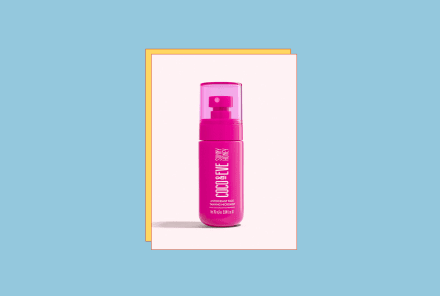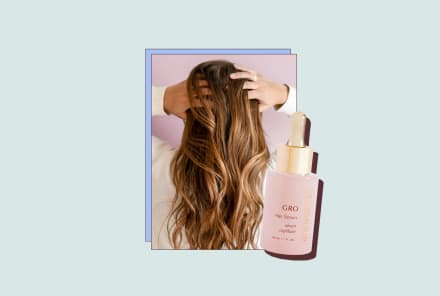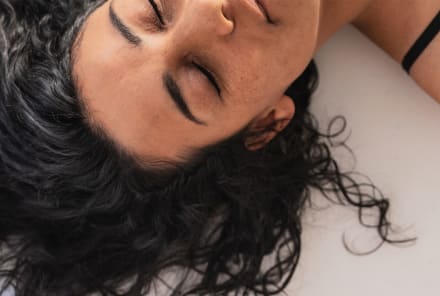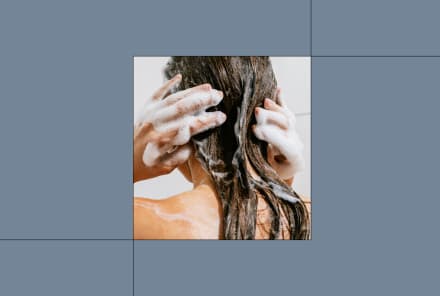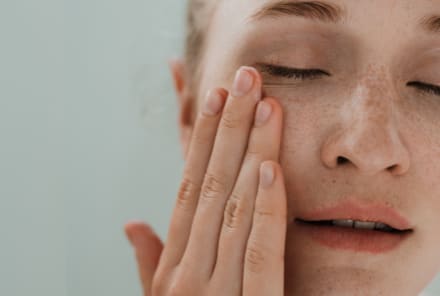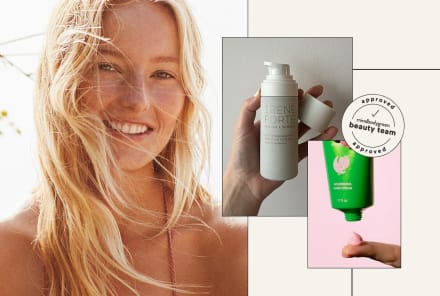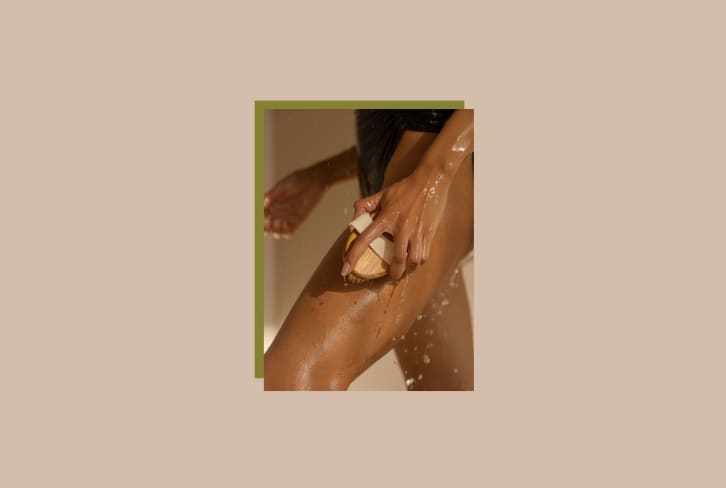Advertisement
What Is Fungal Acne? The Misunderstood Type of "Acne"

Hannah Frye is the Assistant Beauty Editor at mindbodygreen. She has a B.S. in journalism and a minor in women’s, gender, and queer studies from California Polytechnic State University, San Luis Obispo. Hannah has written across lifestyle sections including health, wellness, sustainability, personal development, and more.

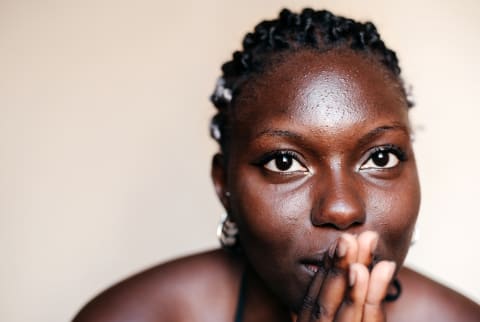
Breakouts come in many shapes and sizes, and they're not always going to be treated the same. The method of action for easing cystic breakouts is different from clearing blackheads or body acne. Hormonal acne? That's another story entirely.
Fungal acne is actually a whole other category—and isn't even acne at all, to begin with. It was given the moniker of "fungal acne" because of the appearance (it looks very similar to acneic breakouts), but as dermatologists will tell you, they're very different things.
Here's what derms want you to know about these breakouts and how to treat them.
What is fungal acne?
"'Fungal acne' is actually not acne at all but rather a type of folliculitis (inflammation of the hair follicle) that results when yeast becomes trapped inside of hair follicles, leading to acneiform pustules and nodules," board-certified dermatologist Rebecca Marcus, M.D., FAAD, tells mbg.
Here's how to spot the difference: "Pityrosporum folliculitis manifest as small red bumps centered around hair follicles," Marcus explains. "Unlike typical acne, fungal folliculitis can itch."
Another telltale sign is that fungal acne will all appear consistent (or, all the bumps will look alike), which is known as monomorphic. However, traditional acne is often polymorphic, which means there will be many kinds of acne (blackheads, whiteheads, cysts) and they'll all appear at different stages, notes board-certified dermatologist Cybele Fishman, M.D.
The area can also help you decipher if it's acne or folliculitis: "The breakouts are most commonly seen on the chest, back, and face," board-certified dermatologist Lian Mack, M.D., FAAD, notes. On the face, it most commonly occurs on the forehead and temples.
It also occurs on all skin tones.
If you can't tell (it isn't always easy), visit your dermatologist. "In the setting of an office visit, a board-certified dermatologist can also perform a scraping of the skin and look under the microscope, which reveals the organism," Mack says.
Summary:
Fungal acne vs. bacterial acne: A quick overview
As we noted, "fungal acne" is not a type of acne at all, but a type of inflammation of the hair follicle caused by yeast. "Bacterial acne" is, well, actual acne. It forms from the result of when sebum (the oily substance that protects your skin from drying out) and sticky skin cells clogging the pores, and specific strains of a bacteria called C. 1
Acnes1 grow inside, leading to inflammation and pimples. (How acne forms is actually quite complex and multifactorial, but this can serve as a brief overview.) So, speaking about the differences between "fungal acne" and "bacterial acne" isn't the most accurate, however, for the purposes of this conversation we'll use the terms to help differentiate between the two.
Want help identifying which type yours might be? Here's a very quick overview:
Fungal acne will have the following symptoms:
- Presents itself as many small red bumps
- Centered around hair follicles
- May itch
- Localized on the chest, back, arms, and forehead
- Caused by yeast
- Consistent appearance (monomorphic)
Acne will have the following symptoms:
- Can be blackheads, white heads, pustules, and cysts
- Caused by bacteria
- Will feel inflamed, tender, and maybe even painful
- Can appear anywhere there are pores
- Can appear as many different stages (polymorphic)
Causes of fungal acne
So how does one get fungal acne? you might be wondering to yourself. Well, it's actually triggered by very common things:
Warm or humid air
"We all have the organism (Malassezia furfur) on our skin. However, there are certain conditions in which the organism thrives," Mack explains. "If you live in a warmer area and tend to be sweaty and have damp skin, you are more likely to experience acne caused by an overgrowth of yeast," she continues.
Airtight clothing
Marcus notes that tight clothing can lead to a fungal acne breakout as well. Especially if the clothing is damp, be it from rain, sweat, or something else, the chance of encouraging fungal growth increases.
Fishman notes that "unbreathable" fabrics are to blame, especially those commonly used for workouts, such as spandex. Always get out of sweaty clothes and rinse off after exercise. Read more about how working can lead to breakouts.
Skipping a shower post-sweat
Speaking of: skipping a shower post workout or when you've recently sweat a lot. This can cause other forms of folliculitis (yeast likes sweat) and may contribute to acne as well—so it's best to prioritize your rinse for more reasons than one. If you find yourself struggling with fungal acne, showering after each workout will help reduce the risk of it getting worse.
However, it is important to note that fungal acne (or typical acne) is not related to lack of cleanliness or hygiene. Having it is not a sign that the skin is "dirty." It is simply that rinsing post sweat can help you manage it.
Friction can worsen the issue.
Remember, fungal acne is actually folliculitis—so it makes sense that friction can make it flare or appear worse. Especially if you're already struggling with a breakout, it's best to wear loosefitting clothes and try not to rub the affected area on any harsh surfaces. As with any lesion or rash, it's vital to not further add to irritation during the healing process.
Immune system
If you just finished antibiotics and see unusual acne-like bumps, it could be fungal acne. "Flares of this condition may be associated with a weakened immune system or the prolonged use of antibiotics," Mack notes. This is because fungal acne is associated with dysbiosis in the skin.
Definition: Dysbiosis
Solutions for fungal acne
Don't worry, tending to your breakouts is totally doable:
Topical products
Some people will use dandruff shampoo on an area affected by fungal acne—this is because these products generally contain zinc pyrithione—like this First Aid Beauty Anti-Dandruff Shampoo — as well as selenium sulfide. These can help deal with yeast overgrowth.
In addition, Fishman notes the use of ketoconazole, which is another common ingredient in anti-fungal shampoos.
"In addition, using products to control oil or sebum production may also help," she notes. Marcus' go-to: The Kate Somerville EradiKate Daily Foaming Cleanser. This gentle cleanser, "helps fight fungus and also bacteria that cause breakouts," Marcus says.
Oral treatments
"Oral treatments with antifungal medications are most effective," Marcus says. Especially if the flare is uncomfortable or painful, this mode of treatment may work quicker than some topical products. You'll need to visit a dermatologist.
Natural remedies
If fungal acne is a recurring problem, you can manage it with natural solutions. (However, for tried-and-true treatments, you should really get oral medications, or topical that contain zinc pyrithione, ketoconazole, and selenium sulfide.) Raw or manuka honey is a common home remedy, as it has antifungal properties. It's also hydrating, anti-inflammatory, and aids in wound healing. A honey mask can be used weekly as maintenance.
Balancing your microbiome
Fungi, yeast, bacteria, and viruses are all a natural and needed part of your skin microbiome. Problems arise when the balance becomes out of whack and certain strains overpower the rest. For example, acne is triggered by an imbalance of specific strains of C. Acnes. And fungal acne is an imbalance of Malassezia furfur.
One way that you can keep your complexion clear is to prioritize keeping your microbiome balanced with a barrier-supporting skin care routine. While this isn't a treatment, it can help keep your skin healthy long term.
Take a probiotic
Remember how we mentioned that fungal acne can appear after antibiotic use and that it’s associated with dysbiosis of the microbiome? Fishman notes that she recommends to patients to incorporate a probiotic supplement into their routine to help manage fungal acne. Here’s our favorite probiotic supplements.
Products to avoid
As with many forms of breakouts and folliculitis, finding products that work for you, in part, calls for removing those that won't. Overly harsh or irritating products should be avoided if you're actively struggling with a fungal acne breakout.
"Avoid granular scrubs, which may further irritate and inflame follicles, worsening folliculitis," Marcus explains. If you use chemical exfoliants or retinol, it's best to minimize your use if you find them irritating during a breakout.
Further, avoid products with fatty acids or oils. "The yeast that causes fungal acne survives on oils and fatty acids, causing the fungal acne to grow and spread," Mack says. "Some examples include lauric acid, palmitic acid, stearic acid, oleic acid, and linoleic acid."
Summary
Prevention tips
The best way to treat something is to avoid it in the first place. Throughout the article, we’ve mentioned some prevention tips, but as a quick reference—here’s how to avoid fungal acne going forward:
- Rinse off post working out
- Avoid airtight clothing
- Don’t stay in damp clothing too long if you can avoid it
- Keep your immune system strong (since a weakened immune system can trigger a flare-up)
- Take a probiotic supplement
- Use topicals that contain zinc pyrithione, ketoconazole, and selenium sulfide
- Use a honey mask can be used weekly as maintenance
- Keep your microbiome balanced with a barrier-supporting skin care routine (not a treatment, but can be used for overall skin health)
- Avoid harsh or irritating topical products as inflammation can make it worse
- Switch to lighter skin care products, and avoid heavy fatty acids or oils, notably those high in lauric acid, palmitic acid, stearic acid, oleic acid, and linoleic acid
How long does fungal acne last?
If left untreated or if you don’t change the behavior that led to it in the first place, you’ll likely continue to experience it until modifications are made. (It usually won’t go away on its own.) However, if you’re able to modify your behaviors and use treatments we discussed in the article, it can clear up in about 3 weeks.
FAQ
What triggers fungal acne on the face?
Fungal acne is typically localized on the body (chest, back, and arms), but can be present on the face as well—typically along the forehead. This is because fungal acne is actually inflammation of the hair follicle caused by yeast, and your hairline tends to have more follicles. It can be triggered by humid environments, trapped moisture, and sweat.
How do you know if your acne is fungal?
Fungal acne is actually inflammation of the hair follicle caused by yeast. It presents itself as many small red bumps, is centered around hair follicles, may itch, and has a consistent appearance (monomorphic). It’s localized on the chest, back, arms, and forehead.
How do I stop getting fungal acne?
Lifestyle habits can help prevent fungal acne, such as rinsing off post sweat, avoiding damp, airtight clothing, and supporting your immune system. You can use topicals that contain zinc pyrithione, ketoconazole, and selenium sulfide. For prolonged cases, visit a dermatologist.
The takeaway
While fungal acne may look like a normal breakout, it's actually not pimples at all. Fungal acne is a type of folliculitis caused by trapped yeast in the hair follicles. This can be triggered by warm, humid air; wearing airtight wet clothing; skipping a shower; or a weakened immune system.
You can use topical products to ease these breakouts, but it's best to visit your dermatologist to find the underlying cause and find the best treatment for your skin. If it's not fungal acne, it may be one of the many other forms of acne—see 7 popular types of breakouts here.
Watch Next
Enjoy some of our favorite clips from classes
Enjoy some of our favorite clips from classes
What Is Meditation?
Mindfulness/Spirituality | Light Watkins
Box Breathing
Mindfulness/Spirituality | Gwen Dittmar
What Breathwork Can Address
Mindfulness/Spirituality | Gwen Dittmar
The 8 Limbs of Yoga - What is Asana?
Yoga | Caley Alyssa
Two Standing Postures to Open Up Tight Hips
Yoga | Caley Alyssa
How Plants Can Optimize Athletic Performance
Nutrition | Rich Roll
What to Eat Before a Workout
Nutrition | Rich Roll
How Ayurveda Helps Us Navigate Modern Life
Nutrition | Sahara Rose
Messages About Love & Relationships
Love & Relationships | Esther Perel
Love Languages
Love & Relationships | Esther Perel
